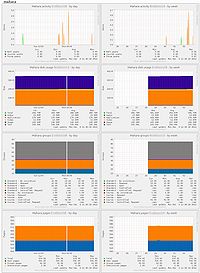Mahara日本語ドキュメント/システム管理者ガイド/MaharaをMuninで監視する
From Mahara Wiki
< Mahara日本語ドキュメント | システム管理者ガイド
作成中です - mits
さまざまなMahara統計データを生成できるMuninプラグインはランカスター大学 (Lancaster University) CISの無償提供により、GitHubにてダウンロードすることができます。これは複数グラフのためのワイルドカードMuninプラグインであり、Maharaデータベースから有用な統計を取得して美しいグラフに表示します。生成されるグラフは以下のとおりです:
- 現在のログインユーザ
- グループ
- ディスク使用量
- ページ
- ユーザ活動
プラグインはMahara 1.5またはそれ以上で使用することができます。現在のところ、PostgreSQLデータベースのみで動作します。
事前要件 (Pre-requires)
あなたのシステムにおいて、Muninをインストールおよび設定する必要があります。これはディスカッションの範囲を超えているため、詳細情報に関して、Munin documentationをご覧ください。
設定
これを動作させるため、あなたはプラグインをインストール、プラグイン設定ファイルの作成およびプラグインへのシンボリックリンク (Moodleデータベース名を反映させるため) を作成する必要があります。
プラグインのインストール
あなたはgitを使用してコピーするか、GitHubからプラグインをダウンロードすることができます。あなたがプラグインをダウンロードした場合、解凍してMunin標準プラグインディレクトリ (例 /usr/share/munin/plugins/) に入れること、またカスタムプラグインを分離したい場合はカスタムディレクトリに入れることができます。
mv /tmp/mahara_ /usr/share/munin/plugins/mahara_
プラグインの設定
あなたは「plugin-conf.d」ディレクトリ内に設定ファイルを作成する必要があります。通常、このディレクトリは「/etc/munin/」となります。設定ファイル名に関して、特定の要件はありませんが、利便性のため「mahara」にした方が良いでしょう。設定には、標準Muninプラグイン設定属性、データベース接続設定のlibpq環境変数 (例 PGUSER, PGHOST等) および プラグイン独自の設定が含まれます。通常、postgresユーザとして、データベースサーバ上でプラグインを直接実行した方が簡単です。この場合、minimum設定は下記のようになります:
[mahara_*] user postgres
あなたのプラグインが異なるサーバにある場合、Maharaデータベースにアクセスするため、さらなる設定が必要となります。プラグインがMunin::Plugin::Pgsqlライブラリを使用する場合、すべてのlibpq変数をサポートします。一般的な変数は下記のとおりです:
- PGHOST - 接続するホスト名
- PGPORT - 接続するポート番号
- PGUSER - 接続するユーザ名
- PGPASSWORD - 接続するパスワード (パスワードが必要な場合)
プラグイン設定で3つの変数を使用するために、あなたは環境設定として渡す必要があります。例) 「env.」を先頭に付加
[mahara_*] user root env.PGHOST your_db_hostname env.PGUSER your_db_username env.PGPASSWORD your_db_password
あなたがプラグインを使用したい場合、同様に環境設定として設定する必要のある独自設定変数があります:
- env.updatetime - あなたは時間ベースのデータを計算するための期間を設定することができます (例 ログインユーザ数レポートまたは課題提出数)。デフォルトでは値300秒 (Munin更新間隔5分) が使用されます。
- env.dbprefix - あなたがMaharaデータベーステーブルで接頭辞を使用する場合、このパラメータを使用して正しい接頭辞を渡してください。
- env.showdefaultpages - デフォルト/システムページ (ユーザダッシュボード、ユーザプロファイル、グループホームページ) をグラフに表示するかどうか指定します。設定にて、この変数の値を「1」にすることができます。デフォルトでは無効にされています。
For more information on Munin plugins configuration see corresponding Munin wiki page.
シンボリックリンク (symlink) を作成する
The final bit that needs to be done is to create a symlink to the plugin in /etc/munin/plugins directory. Being a wildcard plugin, Mahara plugin will attempt to determine the database name it will be using from the symlink, thus the symlink need to contain the name of the Mahara database:
ln -s /usr/share/munin/plugins/mahara_ /etc/munin/plugins/mahara_yourmaharadatabasename
ls -la command run in /usr/share/munin/plugins directory will display that the symlink is correct:
lrwxrwxrwx 1 root root 52 Nov 21 16:29 mahara_mahara-db -> /usr/share/munin/plugins/mahara_
The database name in the example above is mahara-db
The wildcard plugin concept is especially useful for large scale systems when you have more than one Mahara database on the same database server. I this case you may create symlink for each Mahara database on the same system and have them all monitored.
設定およびプラグインのテスト
You will need to restart munin node on the client to make sure it picked up new plugins. Now, you may see what the plugin outputs when it is being queried by Munin service:
~# munin-run mahara_mahara-db
will output the current data values for each graph
multigraph maharausers users.value 1 multigraph maharapages groupportfolio.value 42 instportfolio.value 1 userportfolio.value 531 ...
to see the graphs configuration that plugin returns run
~# munin-run mahara_mahara-db config
You may read more about plugin debugging in Munin wiki document.
役立つヒント
You may set up warning and critical thresholds for particular services on the Munin server side. When one of the values will be above defined limits, the service will be highlighted in the Munin web interface. You may elaborate this further and set up various alerts. For more info see page.
開発者メモ
This Munin Mahara plugin is using Munin::Plugin::Pgsql library, which makes it work with PostgreSQL database only at the moment. It is also a multigraph plugin which allows to keep all the graphs generation code within the same file. The wildcard plugin functionality is implemented the way that it takes database name from the symlink.
You are more than welcome to contribute to this work and create pull request for integration of your changes.
